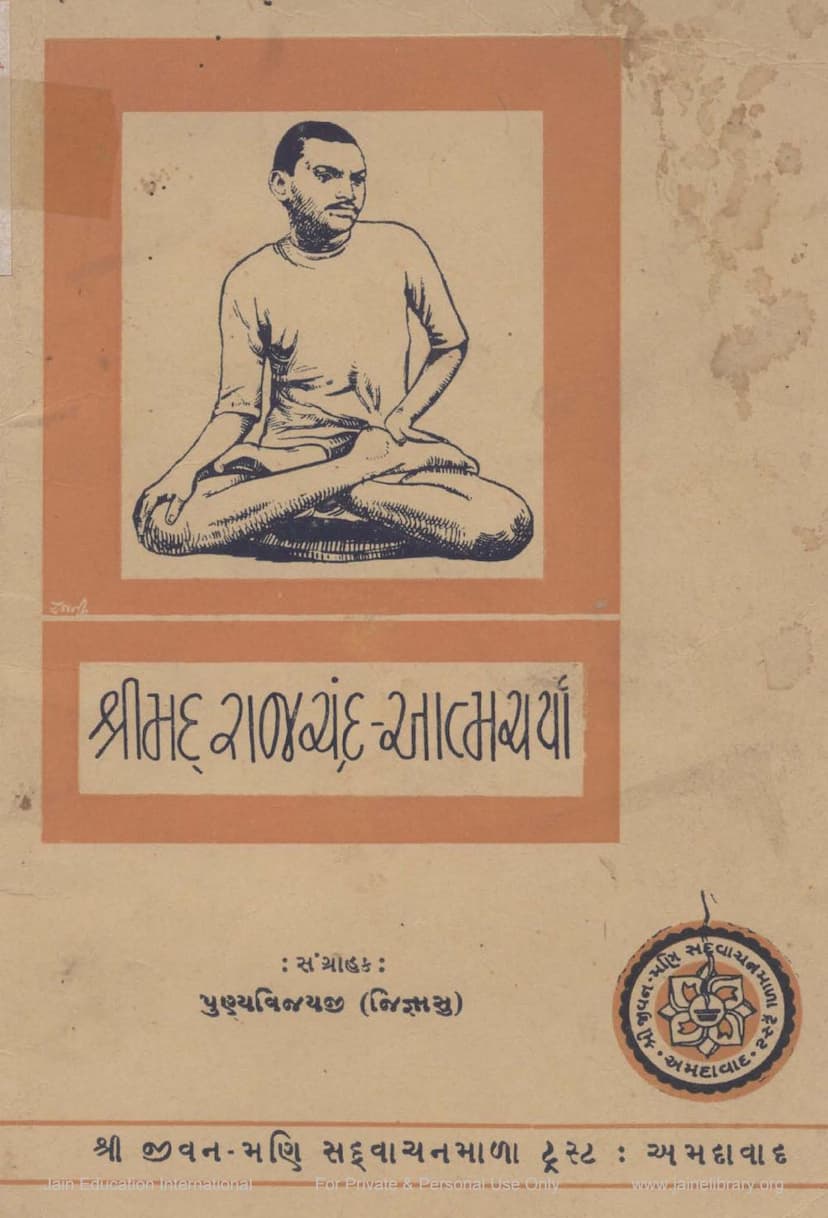Shrimad Rajchandra Atmacharya
Added to library: September 2, 2025

Summary
Here's a comprehensive summary of the Jain text "Shrimad Rajchandra Atmacharya" based on the provided pages:
Book Title: Shrimad Rajchandra Atmacharya (Shrimad Rajchandra's Self-Characterization) Author/Compiler: Punyavijay (Jignasu) Publisher: Jivanmani Sadvachan Mala Trust
This book is a compilation of personal notes and reflections of Shrimad Rajchandra, presented to provide a deeper understanding of his inner spiritual journey and "self-characterization." It aims to offer insights into his profound spiritual experiences and his relentless pursuit of self-realization.
Key Themes and Content:
- Focus on the Soul (Atma): The central theme of the book is the nature of the soul and the path to its realization. Shrimad Rajchandra's life is presented as a testament to an "Atma's life" – a continuous striving for spiritual attainment.
- Distinction Between Body and Soul: A core message emphasized is the fundamental difference between the physical body ("deha") and the soul ("dehi" or "atma"). The book highlights Shrimad Rajchandra's profound realization of this distinction, stating that his "self-awareness was constantly dwelling in the soul," unlike ordinary beings who identify with the body.
- Detachment and Non-Attachment (Vairagya): Shrimad Rajchandra's life is characterized by immense detachment from worldly pleasures and possessions. The text quotes Mahatma Gandhi describing him as a "natural renunciate" who lived "unattached to the world like a lotus in water," even while residing in it. His detachment is attributed to his spiritual realization.
- The Difficulty of Renunciation: The book acknowledges the immense difficulty in overcoming attachments and desires. It quotes Shrimad Rajchandra expressing that freedom from attachment is a state achievable through many lifetimes of effort, and that overcoming passion is incredibly hard.
- The Power of Self-Awareness and Self-Enquiry: Shrimad Rajchandra's personal notes reveal an intense process of introspection and self-examination. He constantly sought to identify even the subtlest faults within himself, as evidenced by references to specific pages in his handwriting.
- The Concept of "Sahaj Samadhi" (Natural Equanimity): The text explains that for Shrimad Rajchandra, who had shed the ego of identification with the body and realized the ultimate truth, natural equanimity (samadhi) became an inherent state of being. This is compared to a devoted wife whose mind remains focused on her husband even while engaged in other duties.
- The Essence of Spiritual Progress: The book emphasizes that true spiritual progress involves the constant refinement of one's inner nature and the realization of the soul's true form. It states that for those who have experienced the Self, their focus remains on their own nature.
- The Illusion of Worldly Pleasures: Shrimad Rajchandra's realization of the soul's pure essence makes all material experiences appear "insignificant." His attachment to transient things is replaced by an unwavering focus on the eternal soul.
- The Struggle with "Uday" (Karma/Destiny): The personal notes reveal Shrimad Rajchandra's internal dialogue and struggle with the influence of his past karma ("uday"). He grapples with how to navigate worldly responsibilities while maintaining his inner spiritual focus. He expresses a desire to shorten worldly affairs while acknowledging the pull of karma.
- Intense Self-Correction and Vigilance: The collection of notes showcases Shrimad Rajchandra's relentless effort to overcome internal weaknesses, including "mand dasha" (lethargy), "uday ki pravritti" (the tendency of karma to manifest), and the influence of worldly interactions. He emphasizes the need for constant vigilance and self-awareness.
- The Goal of Keval Gyan (Omniscience): The text frequently refers to the state of Keval Gyan as the ultimate goal, describing it as the pure, all-encompassing knowledge of the soul and the universe. He dedicates himself to practices that lead to this state.
- Devotion to Tirthankaras and Gurus: Shrimad Rajchandra expresses profound reverence for the Tirthankaras (like Lord Mahavir and Lord Rishabhdev) and his gurus, acknowledging their role in guiding him towards self-realization and understanding the true nature of reality.
- The Nature of Reality and Perception: The book delves into philosophical concepts like the relationship between the self and the world, the nature of perception, and the limitations of worldly views. It advocates for looking beyond mere external forms and focusing on the inner essence.
- The Path to Liberation (Moksha): The ultimate aim discussed is liberation from the cycle of birth and death. This is presented as achievable through the integration of right faith (Samyak Darshan), right knowledge (Samyak Gyan), and right conduct (Samyak Charitra).
Overall Significance:
"Shrimad Rajchandra Atmacharya" is presented as a collection of profound spiritual insights and a testament to the extraordinary inner life of Shrimad Rajchandra. It serves as a guide for seekers who aspire to understand and follow the path of self-realization, emphasizing the importance of intense introspection, detachment, and unwavering devotion to the soul. The compiler, Punyavijay, highlights that by deeply understanding Shrimad Rajchandra's life and writings, readers can draw immense inspiration and potentially achieve their own spiritual liberation.